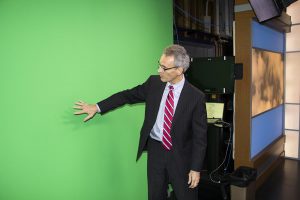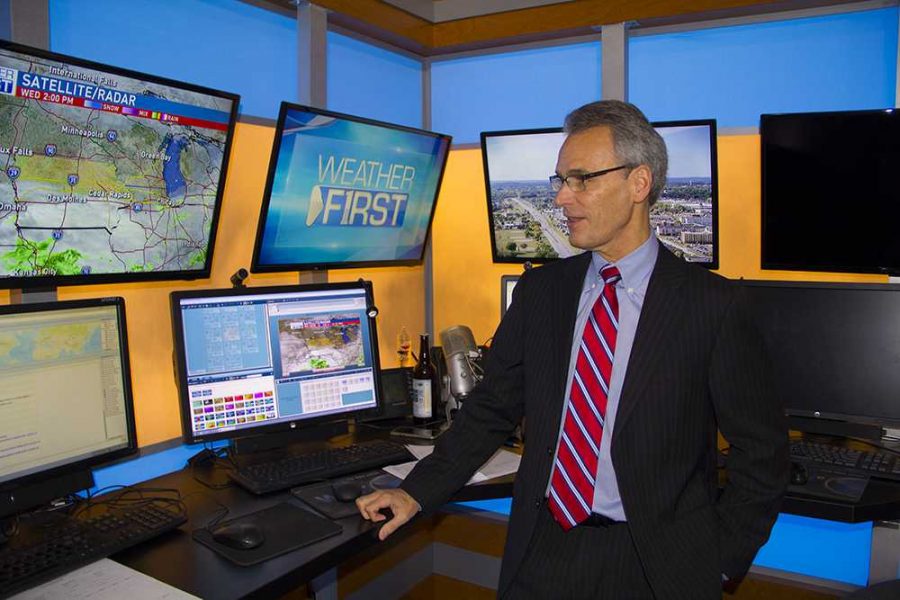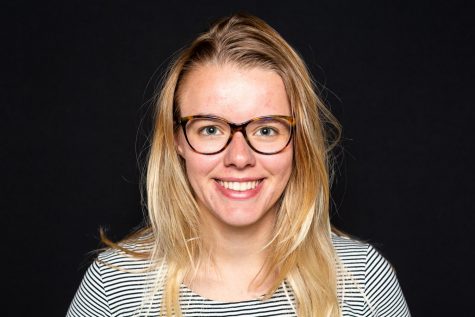Around four times a day, local meteorologist Terry Swails stands before a green screen and addresses eastern Iowa with the day’s forecast.
Swails, the chief meteorologist at KGAN in Cedar Rapids, has spent 41 years telling the story of the weather.
And in the last 41 years, he has seen the weather change.
“I think everybody is beginning to see the impacts [of climate change] are pretty widespread,” he said.
However, Swails encounters a number of challenges when talking about climate change as a forecaster, including a lack of time and treading tricky political lines.
More people trust their local news stations than national news stations, a Pew Research study found, and weather coverage is a major component of the local stations.
A 2015 study conducted in Virginia found that people who paid attention to their local TV weather programs believed extreme weather events were becoming more frequent. The study says this finding adds to literature “suggesting that TV weathercasters can play an important role in educating the public about climate change.”
Jerry Schnoor, a co-director of the Center for Global and Regional Environmental Research at the University of Iowa, said he thinks national stations do a better job of discussing climate change than local stations.
“It always surprises me that [local forecasters] don’t talk more about climate change and whether it affects a certain event or not,” Schnoor said.
Eastern Iowa has had its share of catastrophic weather events. Notably, the floods of 2008, which resulted in $10 billion in damage across Iowa and damaged several buildings on the UI campus.
Swails’ résumé includes coverage of the Iowa floods and a disastrous F5 tornado in Parkersburg, Iowa, that occurred three weeks prior and claimed seven lives. He also reported on Hurricanes Harvey, Irma, and Maria this year, which devastated Texas, Florida, and Puerto Rico.
He said the extreme nature of these events could have been exacerbated by the warming climate, because warmer air can hold more moisture, leading to heavier rainfalls.
Swails said dew points, which indicate the amount of moisture in the air, have been remarkably high since he started at KGAN three years ago. Since 2000, 11 summers have had above-average dew points in Cedar Rapids.
The changing climate will have consequences, Swails said, including stronger storms, more flooding, extreme humidity, and heavier snowfall.
“I think we’ll see more of these extreme weather events here in eastern Iowa,” he said. “So as forecasters, we’ll get more of that to deal with.”

Swails said he does not have much opportunity to talk about this during his coverage. His segments are just long enough to tell what is happening.
However, he said, he has no doubt he could discuss climate more in-depth on KGAN, and he will likely do that in the near future.
“We don’t have any policy against [talking about climate change] whatsoever,” Swails said.
KCRG in Cedar Rapids also has no policy against speaking about climate change on the air, KCRG News Director Adam Carros said, and added all reports must be factually based, not opinionated.
“The causes of climate change, which is the real controversy, would be left to expert opinions from climate scientists,” Carros said in an email to The Daily Iowan.
Mark Schnackenberg, the chief meteorologist at KWWL in Waterloo, rarely includes climate-change discussion in his weather forecasts. He said he does not doubt whether climate change is happening, but it does not have a place in his forecasts.
“Ninety-nine percent of the time, with 99 percent of the people, [viewers] just want to know what the weather’s doing, how it’s going to affect their life,” Schnackenberg said.
The climate has been changing since the beginning of time, he said, and the amount of reliable data that exist only covers a speck of time.
“We see [climate has] been changing, it’s getting warmer,” Schnackenberg said. “How and why? That’s a debatable question, but when we do forecasts, that’s not something we really consider.”
Swails does have some reservations about talking about the issue on TV, because of the controversy surrounding it.
A Gallup Poll published in June showed 66 percent of Democrats worry “a great deal” about climate change, while just 18 percent of Republicans share this belief.









